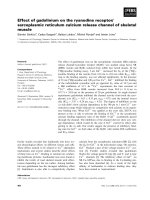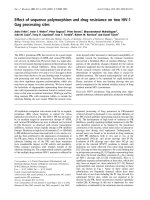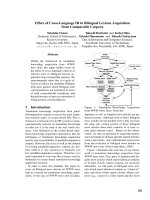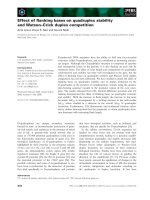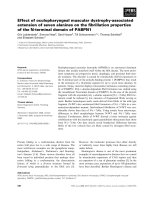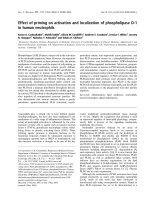báo cáo khoa học: " Effect of mesoporous silica under Neisseria meningitidis transformation process: environmental effects under meningococci transformation" ppt
Bạn đang xem bản rút gọn của tài liệu. Xem và tải ngay bản đầy đủ của tài liệu tại đây (820.18 KB, 8 trang )
SHOR T COMM U N I C A TION Open Access
Effect of mesoporous silica under Neisseria
meningitidis transformation process:
environmental effects under meningococci
transformation
Luciana M Hollanda
1
, Gisele CG Cury
1
, Rafaella FC Pereira
1
, Gracielle A Ferreira
2
, Andreza Sousa
2
, Edesia MB Sousa
2
and Marcelo Lancellotti
1*
Abstract
Background: This study aimed the use of mesoporous silica un der the naturally transformable Neisseria
meningitidis, an important pathogen implicated in the genetic horizontal transfer of DNA causing a escape of the
principal vaccination measures worldwide by the capsular switching process. This study verified the effects of
mesoporous silica under N. meningitidis transformation specifically under the capsular replacement.
Methods: we used three different mesoporous silica particles to verify their action in N. meningitis transformation
frequency.
Results: we verified the increase in the capsular gene replacement of this bacterium with the three mesoporous
silica nanoparticles.
Conclusion: the mesouporous silica particles were capable of increasing the capsule replacement frequency in N.
meningitidis.
Findings
Freshly isolated Neisseria meningitid is ar e naturally com-
petent and exchange genetic information with each other
by this process. They are also k nown as a commensal
bacterium of the human upper respiratory tract that may
occasionally provoke invasive infections such as septice-
mia and meningitis. This natural competence has been
directly correlated to pilliation of these organisms [1] as
well as a specific uptake sequence contained multifold
within the genome of these bacteria. Pilliated strains are
easily transformed by direct incubation with a plasmid
containing the uptake sequence or chromosomal DNA
[2]. The advantages of doing genetic manipulations
within these well-known strains are numerous. Develop-
ment of systems to construct specific genomic mutations
has been used to study their pathogenesis [3-5].
The use of the mutations for the study of the capsular
polysaccharide of N. meningitidis allowed the advances in
the meningococci pathogenesis understandings [6-8]. The
capsular polysaccharide is a major virulence factor and a
protective antigen. Meningococcal s trains are classified
into 12 different serogroups according to their capsular
immune specificity, among wich the serogroups A, B, C, Y
and W135 are the most frequently found in invasive infec-
tions. The capsule of serogroups B, C, Y and W135 strains
is composed of either homopolymers (B and C) or hetero-
polymers (Y and W135) of sialic acid-containing polysac-
charides that are specifically linked, depending on the
serogroup [9-11]. This polymerization is mediated by the
polysialyltransferase, encoded by the siaD gene in strains
of serogroups B and C (also called synD and synE, respec-
tively) and by synG in serogroup W135. Capsule switching
after replacement of synE, in a serogroup C strain, by synG
may result from the conversion of capsule genes by trans-
formation and allelic recombination [3,12,13]. The capsule
switching from serogroup C to B N. meningitidis was
* Correspondence:
1
Department of Biochemistry, Institute of Biology CP6109, State University of
Campinas UNICAMP, CP: 6109-CEP 13083-970, Campinas, SP, Brazil
Full list of author information is available at the end of the article
Hollanda et al. Journal of Nanobiotechnology 2011, 9:28
/>© 2011 Hollanda et al; licensee BioMed Central Ltd. This is an Open Access article distributed und er the terms of the Creative
Commons Attribution License ( /by/2.0), which permits unrestricted u se, distribution, and
reproduction in any medium, provided the original work is properly cited.
observed in several countries after vaccination campaigns
[3,14-17]. It might explain the emergence and the clonal
expansion of strains of serogroup W135 of N. meningitidis
in the year 2000 among Hajj pilgrims who had been vacci-
nated against meningococci of serogroups A and C
[11,18]. The se W135 strains belong to the same clonal
complex ET-37/ST-11 as prominent serogroup C strains
involved in outbreaks worldwide [12,19]. Hence, the emer-
gence of these W135 strains in epidemic conditions raised
the question about a possible capsule switching as an
escape mechanism to vaccine-induced immunity. Also,
these events are expected to occur continuously and can
be selected by immune response agai nst a particular cap-
sular polysaccharide [11]. However, the interference of
immune response with transformation efficacy has not yet
been evaluated. Specific capsular antibodies are expected
to bind to the bacterial surface and hence the interference
in DNA recognition and uptake.
In addition, environmental interference o n the trans-
formation process of this bacterium is also unknown.
This work aimed at the use of different mesoporous silica
SBA-15, SBA-16 and [SBA-1 5/P(N-iPAAm)], an organic-
inorganic hybrids systems based on mesoporous materi-
als and stimuli-responsive polymers, for the study of
these nanostructures effect on the transformation process
of meningococci, specifically their functions on ca psular
switching process. Mesoporous silica materials are a fairly
new type of material t hat has pores in the mesoscopic
range of 2-50 nm. The characteristic features of ordered
mesoporous materials are their monodispersed and
adjustable pore size in an inert and biocompatible matrix
with an easily modified surface. The intrinsic uniform
porous structure of this class of compounds with their
large specific surface area and pore volume, associated
with surface silanol groups, makes these materials suita-
ble as an adsorbent model for studies involving surface
phenomena. The methods used in this work ve rified the
effect of mesoporous silica SBA-15, SBA-16 and [SBA-
15/P(N-iPAAm)] on the transformation of the serogroup
C N. meningitidis ag ainst two different donor DNA
obtained from mutants of this microorganism (M2 and
M6).
The characteristics of the strains (N. meningitidis and
Escherichia coli) used in this study are described in Table
1. N. mening itid is were grown a t 37°C under 5% CO2 on
GCB agar medium (Difco) containing the supplemen ts
described by Taha et al, [20]. When needed, culture
media were supplemented with erythromycin at 2 μg/ml
and spectomycin at 40 μg/ml. E. coli strains used for plas-
mid preparations were DH5a.
The mesoporous silica nanoparticles SBA-15, SBA-16
and [SBA-15/P(N-iPAAm)] were characterized by Sousa
et al. [21]. Both, SBA-15 and SBA-16 are composed of
SiO
2
but the characteristic features of SBA-15 are the
presence of channels arranged in a t wo-dimensional
hexagonal structure and wheat like macroscopic mor-
phology with mean sizes in micrometer scale which con-
sist of many ropelike aggregates. On the other hand,
SBA-16 is an example of ordered mesoporous silica with
a three dimensional cubic cage structure with three
dimensional channel connectivity. Also, in SBA-16 the
arrays of the ordered and uniform pores can be
observed for which each spherical particle is a single
crystal arranged in cubic structure.
The SEM images of SBA15 evidence the presence of
elongated, 590 nm-wide vermicular shaped particles. SBA-
15 consist s of many rope-like domains with average sizes
of 1.7 μm aggregated into wheat-like macrostructures,
Figure 1(a). A similar morphology is observed after the
polymerization o f P( N-iPAAm) insid e the SBA-15 net-
work, presenting 450 nm width (data not showed). TEM
image of SBA-15 shows a well-defined hexagonal arrange-
ment of uniform pores when the incident electron beam
was parallel to the main axis of the mesoporo us (Figure
1b), and unidirectional channels, when the electron beam
was perpend icular to t he ch annel axis (Figure 1c). The
SBA-16 particle observed from SEM exhibits rounded
shape with diameter size between 15 and 20 μmwithan
“aggregated morphology”. The corresponding TEM images
of the SBA-16, Figure 2, showed well arranged cubic
mesopores what confirmed the 3D cubic pore structure.
Some meso porous textural propert ies of SBA-15 and
SBA-16 were obtained b y the nitrogen adsorption mea-
sure. Table 2 summarizes these properties of SBA-15 and
Table 1 Bacterial Strains used in this work
Strain Characteristics Origin (Reference)
DH5∝ Escherichia coli F-, endA1, hsdR17 c, supE44, thi-1, gir A96, relA1 [44]
pLAN45 Plasmid containing ΔNMB0065::ΩaaDA This work
pLAN13 Plasmid containning the fusion of synG::ermAM This work
C2135 Neisseria meningitidis serogroup C, BIOMERIEUX INCQS-FIOCRUZ
W135
ATCC
Neisseria meningitidis serogroup W135, ATCC35559 INCQS-FIOCRUZ
M2 N.meningitidis isogenic mutant ΔNMB0065:: ΩaaDA This work
M6 W135
ATCC
transformed with pLAN13 to generate a fusioned strain synG:ermAM This work
Hollanda et al. Journal of Nanobiotechnology 2011, 9:28
/>Page 2 of 8
SBA-16. BET-specific surface area, S
BET
, was calculated
from adsorption data in the relative pressure interval P/P
0
= 0.045-0.25. A cross-sectional area of 0.162 nm
2
was used
for the nitrogen molecule in the BET calculations. The
total pore volume, V
p
, was calculated from the amount of
N
2
adsorbed at the highest P/P
0
(P/P
0
= 0.99). The pore
diameter, D
BJH
, was calculated using the adsorption
branches of the nitrogen isotherms employing t he BJH
algorithm. SBA-15, SBA-16 and SBA-15/P(N-iPAAm)
have small pore diameters from 3.7 t o 5.7 nm with very
narrow pore size distributions (data not shown). Total
pore volumes for SBA-15, SBA-16 and SBA-15/P(N-
iPAAm) can also be calculated to be 0.96 cm
3
/g, 0.49 cm
3
/
g and 0.48 cm
3
/g, respectively. SBA-15 has a higher sur-
face area than the SBA-16 and SBA-15/P(N-iPAAm).
Recombinant DNA protocols as cloning plasmids,
PCR amplifications, insertion of resistance cassettes and
transformation were performed as described previously
[20,22]. The oligonucleotides used are listed in Table 3.
All the mutants obtained by homologous recombination
were checked by PCR analysis using a oligonucleotide
harboring the target gene and another harboring the
cassette. The Figures 3 and 4 describe the design of
mutant s-M2 and M6, respect ively, whose genomic DNA
were extracted for gene transfer in C2135 receptor
strain.
A preliminary analysis of the action of the mesoporous
silica was perfor med to determine t he influence of this
nanostructure under Neisser ia meningitidis growth. The
results did not show any influence on bacterial growth
of the presence of DNA in addition of SBa15, SBa16 or
SBA-15/P(N-iPAAm) (data not showed).
The first mutant referent to NMB0065 sequence
mutants was the strain M2, this mutant had the
NMB0065 sequence from N. meningitidis C2135 ampli-
fied using 03.12-3 and 03.12-4 oligonucleotides (Table 3).
This fragment was cloned into the pGEM-T Easy Vector
Syst em II (Promega Corporation, Madison, WI, USA), to
generate the plasmid pLAN6. E. coli strain Z501 was
transformed with plasmid pLAN6 resulting in the plas-
mid pLAN7. The ΩaaDA cassette was inserted into the
BclI site of pLAN7 to generate plasmid pLAN45, which
was transformed into the C2135 strain to generate the
strain M2 (Figure 3).
The construction of serogroup W135 mutants with
transcriptional fusion synG:: ermAM was initiated by
amplifying the region of synG gene using the 98-30 and
03-12-5 oligonucleotides (Table 3) on DNA from the
serogroup W135atcc strain. The amplified fragment was
cloned into the pGEM-T Easy Vector System I (Pro-
mega,Madison,WI,USA),togeneratetheplasmid
pLAN11. Another fragment was ampl ified using the 04-
02-2/galECK29A from synG downstream sequence,
cloned into pGEM-T Easy Vector, to generate pLAN52.
The ermAM cassette was amplified by ERAM1/ERAM3
and in sered into NcoI site of pLAN52 to generate
pLAN53. The fragment amplified from pLAN53 with
the ERAM1 and galECK29A [23] was inserted into PstI
site of pLAN11 to generate pLAN13-2. This plasmid
was linearised by the enzyme SphI and transformed into
W135
ATCC
strain to generate the synG::ermAM fusion
strain M6, erythromycin resistant (Figure 4).
The analysis of transfor mation index on SBA-15/SBA-
16 nanoparticles action is performed adding of each one
in 1.10
8
colony forming units (CFU) the receptor strain
C2135 was added of 1 μgofM2orM6genomicDNA
and 30 μg of different mesoporous silica in well plates
(table 4 and Figure 5). A negative control was also per-
formed without mesoporous silica. The suspension was
Figure 1 (a) SEM image of SBA- 15 which evidence the
presence of elongated, vermicular shaped particles 590 nm
wide. TEM image of SBA-15, which shows a well-defined hexagonal
arrangement of uniform pores when (b) the incident electron beam
was parallel to the main axis of the mesopores and unidirectional
channels, and (c) the electron beam was perpendicular to the
channel axis.
Figure 2 (a) SEM image of SBA-16 exhibits rounded shape with
diameter size between 15 and 20 μm and of an “aggregated
morphology”. TEM images of SBA-16 showed well ordered cubic
mesoporous which confirmed the 3D cubic pore structure, when
(b) viewed along the pore axis and (c) perpendicularly to the pore
axis.
Table 2 N
2
adsorption results
Sample D
BJH
(nm) S
BET
(m
2
.g
-1
)V
p
(cm
3
.g
-1
)
SBA-16 3.7 550 0.49
SBA-15 5.7 672 0.96
SBA-15/P(N-iPAAm) 3.7 326 0.48
S
BE
T is the specific area, D
BJH
is the average pore diameter and V
p
is the
average pore volume.
Hollanda et al. Journal of Nanobiotechnology 2011, 9:28
/>Page 3 of 8
Table 3 Oligonucleotides used in this work
Oligonucleotide Sequence 5’-3’ Description
03.12-3 TGCGGATCCGCAGTAATTTTATCGGTTGG NMB0065 forward
03.12-4 CCCCACTACCTAAAAAATGCTGATTTG NMB0065 reverse
aadA1 TGCCGTCACGCAACTGGTCCA ΩaaDA forward
aadA2 CAACTGATCTGCGCGCGAGGC ΩaaDA reverse
98.30 GGTGAATCTTCCGAGCAGGAAA synG forward
98.31 AAAGCTGCGCGGAAGAATAGTG synG reverse
03.12-5* TCGGGATCCTTATTTTTCTTGGCCAAAAA synG reverse
04.02-1 CAATGAATCTCGCGTTGCTGTAGGTG synG forward
04.02-2 GAAAAATAATTTGGGGCTTAGG synG forward
galECK29A CTTCCATCATTTGTGCAAGGCTGC galE reverse
ERAM1 GCAAACTTAAGAGTGTGTTGATAG ermAM forward
ERAM3 AAGCTTGCCGTCTGAATGGGACCTCTTTA GCTTCTTGG ermAM reverse
*The underlined sequences in italic are the insertion of the BamHI site into original sequence
Figure 3 Schematic representation of the ca psule genes of C serogroup in disrupted construction of NMB0065 gene with aaDA
cassette. The NMB0065 gene was amplified using the 03-12-3 and 03-12-4 oligonucleotides (Table 3) from C2135 strain. This fragment was
cloned into the pGEM-T Easy Vector System II (Promega Corporation, Madison, WI, USA), to generate the plasmid pLAN6. E. coli strain Z501 was
transformed with plasmid pLAN6 resulting in the plasmid pLAN7. The ΩaaDA cassette was inserted into the BclI site of pLAN7 to generate
plasmid pLAN45, which was transformed into the C2135 strain to generate the isogenic mutant strain M2.
Hollanda et al. Journal of Nanobiotechnology 2011, 9:28
/>Page 4 of 8
incubatedat37°CinCO
2
atmosphere by three hours in
these conditions. The counts of total cfu were per-
formed in GCB spectinomycin or erythromycin plates in
triplicate analysis (for M2 and M6 isogenic mutants
respectively). The CFU obtained in plates containing
specific antibiotic were analyzed by PCR, searching the
presence of target gene tra nsfer in the transforming
units (ΩaaDA cassette for the M2 DNA and synG for
M6 donor DNA).
The graphic of Figure 5 shows significant increase of
transformation frequencies using M2 and M6 donor
DNA and the mesoporous silica SBA-15, SBA-16 and
SBA-15/P(N-iPAAm).TheuseofadifferentDNA
donor had as aim the certification of the independence
of mesoporous silica effect on the same bacterial strain-
N. meningitidis C2135. The analysis of the PCR had
demonstrated the transfer of the gene synG from M6
donor strains to C2135 receptor strain (data not
showed).
The data analyses were made by ratio values between
the numbers of transformants CFU obtained with meso-
porous silica action by the median value of
Figure 4 Schematic representation of the capsule genes of W135 serogroup in transcriptional fusion of synG with ermAM cassette. The
synG gene responsible for the synthesis of the W135 capsule was amplified using the 98-30 and 03-12-5 oligonucleotides (Table 3) from
W135
ATCC
strain. The amplified fragment was cloned into the pGEM-T Easy Vector System I (Promega, Madison, WI, USA), to generate the
plasmid pLAN11. In the same conditions, another fragment was amplified using the 04.02-2/galECK29A from synG downstream sequence to
generate pLAN52. The ermAM cassette was insered into NcoI site of pLAN52 to generate pLAN53. The fragment amplified from pLAN53 with the
ERAM1 and galECK29A (Dolan Livengood [23] et al., 2003) was insered into PstI site of pLAN11 to generate pLAN13-2. This plasmid was
linearised by the enzyme SphI and transformed into W135
ATCC
strain to generate the synG::ermAM strain M6, erythromycin resistant.
Hollanda et al. Journal of Nanobiotechnology 2011, 9:28
/>Page 5 of 8
transformants CFU obtained without silica treatment.
The values were analyzed by ANOVA one-way analysis
of variance (Tukey test compared each treatment to
control without mesoporous silica in tr ansformation).
The meningococci growth was not affected by the pre-
sence of mesoporous silica (data not shown).
As showed in table 4, the significant values of P < 0.05
obtained in the ratio values between transformation
using the donors M2 and M6 mutants DNA, respec-
tively. These values are considered significant when
compared with the t ransformation frequency obtained
from negativ e control without silica action. Thus, the
actions of mesopourous silica under the meningococci
transformation increased the capacity of the C2135
strains, specially using the construction M6, directly
implicated in the capsular switching outbreaks.
Despite the exact mechanism of the capsular switching
is still under inves tigation, we proposed that this process
is related to the action of mesoporous silica structures in
the transformation frequencies in 1.10
8
cfu, with a signifi-
cant increase when mesop orous silica was used. The
behavior of SBA-16, regarding to transformation process
of C2135 strain with donor DNA from M2 mutant, was
different from that observed for the others. This nano-
particle showed increase of transformation frequency
more than SBA-15, and SBA-15/P(N-iPAAm) mesopor-
ous silica. Besides the differences in the textural proper-
ties showed in Table 2, a probable cause for the different
responses is the presence of singular morphological
arrangements, as they are hierarchically organized in a
special way. Moreover, it is worth noticing that the three-
dimensional interconnected pore structure of sample
SBA-16 can facilitate the occurrence of adsorption.
The important information is the chromosomal locali-
zation of the NMB0065 and synG gene. Both are gene of
bacter ial chromosome and their biological characteristics
determined in Neisseria meningitidis when these genes
are recombined onto chromosomes level. Nevertheless,
N. meningitidis rarely replicate the plasmids provided
from E.coli constructions, as those performed in these
work (plasmids from pLAN series), exceptionally when in
the plasmid carrier antibiotic re sistant from another spe-
cies of Neisseria as N. gonorrhoeae [24-26].
Also the practical implicatio ns of the silica action
under meningococci are very important to the workers
that usually are exposed at these nanoparticles [27-29].
The careful action of adopting the safety measures not
only the silicosis [30-33] but also for adopting safety
mesures to prevent not only silicosis but a lso changing
pathology and host adaptation of N. meningitidis, will be
important in places where silica nanoparticles are pre-
sent, especially in aerosols. This work is the first to cite
the relationships between the silica risks of health
caused by meningococcal capsular switching or capsular
replacement. This neglecte d process is described just as
an immunologically controlled phenomenon not
Table 4 Values obtained from C21 35 Transformation using the donor DNA from M2 and M6 mutants
Donor DNA (1 μg) Mean of the UCF transformants
obtained in 1.10
8
UFC
Ratio (means obtained exposed to silica/
mean of negative control)
P values (one way
Tukey’s test)
Negative Control (without
mesoporous silica) M2
932 ± 175,50 1,00 ± 0,11
SBa 15 + DNA M2 1696 ± 73,30 1,52 ± 0,25 (P < 0,05)
SBa 16 + DNA M2 1840 ± 423,32 1,97 ± 0,22 (P < 0,05)
SBa 15 (P(N-iPAAm) + DNA M2 1544 ± 358,10 1,38 ± 0,05 (P < 0,05)
Negative Control (without
mesoporous silica) M6
106 ± 10,00 0,92 ± 0,06
SBa 15 + DNA M6 364,33 ± 117,11 3,17 ± 0,80 0,0475 (P < 0,05)
SBa 16 + DNA M6 558,70 ± 59,56 4,50 ± 0,43 0,0008 (P < 0,05)
SBa 15 (P(N-iPAAm) + DNA M6 598,67 ± 107,56 5,20 ± 0,80 0,0058 (P < 0,05)
Figure 5 Graphic of the transformation ratio obtained with In
A: ratio of transformation of C2135 strain with donor DNA
from M2 mutant (ΔNMB0065:: ΩaaDA), In B: ratio of
transformation of C2135 strain with donor DNA from M6
mutant (synG:: ermAM), mimicking a capsular switch
replacement, significant analysis of both tests were performed
by Tukey test comparing separately each treatment SBA-15,
SBA-16 and SBA-15/P(N-iPAAm) with the control without
nanoparticles (w/o).
Hollanda et al. Journal of Nanobiotechnology 2011, 9:28
/>Page 6 of 8
involving the environmental influences such as the pre-
sence of the nanostructures in the atmosphere.
Nevertheless, the capsular switching is described in
regions as the sub Saharan Africa [11,34-36] and Saudi
Arabia (Hajj pilgrimage) [34,37-43] in desert zones
where probably silica nanostructures are present that
facilities the capsular switching process. New experi-
ments using the animal models could confirm this
hypothesis and has been performed by the research
group for Neisseria meningitdis and other natural com-
petent bacteria as Streptococcus pneumoniae and Hae-
mophilus influenzae.
Acknowledgements
This study has been financier supported by CAPES, FAPESP, CNPq and
FAPEMIG. These supports help us to reagent supply and equipments for all
this research development. FAPESP (number 2008/56777-5) and CNPq
(number 575313/2008-0) funding the Laboratory of Biotechnology
(Coordinated by M.L.). FAPEMIG funding the laboratory coordinated by E.M.B.
S. CNPq and CAPES funding with the personal fellowships for students: R.F.C.
P., AS and GAF. Thanks for the English revision for Luiz Paulo Manzo, Júlia N.
Varela and Maria Cecília T. Amstalden.
Author details
1
Department of Biochemistry, Institute of Biology CP6109, State University of
Campinas UNICAMP, CP: 6109-CEP 13083-970, Campinas, SP, Brazil.
2
National
Commission of Nuclear Energy, Center of Development of Nuclear Energy,
Nanotechnology Services. CP: 941-CEP 30123-970, Belo Horizonte, MG, Brazil.
Authors’ contributions
LH carried out the molecular genetic studies; GC carried out the Molecul ar
Biology design and plasmids; RP carried out the molecular microbiologic
tests; GF carried out the mesoporous silica electronic microscopy; AS carried
out the mesoporous silica synthesis; ES carried out the mesoporous silica
synthesis and design, participated in the sequence alignment and drafted
the manuscript; ML carried out the molecular genetic studies, participated in
the sequence alignment and drafted the manuscr ipt.
All the authors read and approved the final manuscript.
Competing interests
The authors declare that they have no competing interests.
Received: 12 March 2011 Accepted: 25 July 2011
Published: 25 July 2011
References
1. Tonjum T, Koomey M: The pilus colonization factor of pathogenic
neisserial species: organelle biogenesis and structure/function
relationships–a review. Gene 1997, 192:155-163.
2. Goodman SD, Scocca JJ: Factors influencing the specific interaction of
Neisseria gonorrhoeae with transforming DNA. J Bacteriol 1991,
173:5921-5923.
3. Swartley JS, Marfin AA, Edupuganti S, Liu LJ, Cieslak P, Perkins B, Wenger JD,
Stephens DS: Capsule switching of Neisseria meningitidis. Proc Natl Acad
Sci USA 1997, 94:271-276.
4. Zhou D, Stephens DS, Gibson BW, Engstrom JJ, McAllister CF, Lee FK,
Apicella MA: Lipooligosaccharide biosynthesis in pathogenic Neisseria.
Cloning, identification, and characterization of the phosphoglucomutase
gene. J Biol Chem 1994, 269:11162-11169.
5. Stephens DS, McGee ZA, Melly MA, Hoffman LH, Gregg CR: Attachment of
pathogenic Neisseria to human mucosal surfaces: role in pathogenesis.
Infection 1982, 10:192-195.
6. Alonso JM, Guiyoule A, Zarantonelli ML, Ramisse F, Pires R, Antignac A,
Deghmane AE, Huerre M, van der Werf S, Taha MK: A model of
meningococcal bacteremia after respiratory superinfection in influenza
A virus-infected mice. FEMS Microbiol Lett 2003, 222:99-106.
7. Nassif X, So M: Interaction of pathogenic neisseriae with nonphagocytic
cells. Clin Microbiol Rev 1995, 8:376-388.
8. Spinosa MR, Progida C, Tala A, Cogli L, Alifano P, Bucci C: The Neisseria
meningitidis capsule is important for intracellular survival in human cells.
Infect Immun 2007, 75:3594-3603.
9. Frosch M, Muller D, Bousset K, Muller A: Conserved outer membrane
protein of Neisseria meningitidis involved in capsule expression. Infect
Immun 1992, 60:798-803.
10. Taha MK, Parent Du Chatelet I, Schlumberger M, Sanou I, Djibo S, de
Chabalier F, Alonso JM: Neisseria meningitidis serogroups W135 and A
were equally prevalent among meningitis cases occurring at the end of
the 2001 epidemics in Burkina Faso and Niger. J Clin Microbiol 2002,
40:1083-1084.
11. Taha MK, Antignac A, Renault P, Perrocheau A, Levy-bruhl D, Nicolas P,
Alonso JM: Clonal spread of Neisseria meningitidis W135. Presse Med 2001,
30:1535-1538.
12. Lancellotti M, Guiyoule A, Ruckly C, Hong E, Alonso JM, Taha MK:
Conserved virulence of C to B capsule switched Neisseria meningitidis
clinical isolates belonging to ET-37/ST-11 clonal complex. Microbes Infect
2006, 8:191-196.
13. Zarantonelli ML, Lancellotti M, Deghmane AE, Giorgini D, Hong E, Ruckly C,
Alonso JM, Taha MK: Hyperinvasive genotypes of Neisseria meningitidis in
France. Clin Microbiol Infect 2008, 14:467-472.
14. Kriz P, Kriz B, Svandova E, Musilek M: Antimeningococcal herd immunity in
the Czech Republic–influence of an emerging clone, Neisseria
meningitidis ET-15/37. Epidemiol Infect 1999, 123:193-200.
15. Alcala B, Salcedo C, Arreaza L, Abad R, Enriquez R, De La Fuente L, Uria MJ,
Vazquez JA: Antigenic and/or phase variation of PorA protein in non-
subtypable Neisseria meningitidis strains isolated in Spain. J Med Microbiol
2004, 53:515-518.
16. Perez-Trallero E, Vicente D, Montes M, Cisterna R: Positive effect of
meningococcal C vaccination on serogroup replacement in Neisseria
meningitidis. Lancet 2002, 360:953.
17. Stefanelli P, Fazio C, Neri A, Sofia T, Mastrantonio P: First report of capsule
replacement among electrophoretic type 37 Neisseria meningitidis strains
in Italy. J Clin Microbiol 2003, 41:5783-5786.
18. Taha MK, Bichier E, Perrocheau A, Alonso JM: Circumvention of herd
immunity during an outbreak of meningococcal disease could be
correlated to escape mutation in the porA gene of Neisseria meningitidis.
Infect Immun 2001, 69:1971-1973.
19. Zarantonelli ML, Antignac A, Lancellotti M, Guiyoule A, Alonso JM, Taha MK:
Immunogenicity of meningococcal PBP2 during natural infection and
protective activity of anti-PBP2 antibodies against meningococcal
bacteraemia in mice. J Antimicrob Chemother 2006, 57:924-930.
20. Taha MK, Morand PC, Pereira Y, Eugene E, Giorgini D, Larribe M, Nassif X:
Pilus-mediated adhesion of Neisseria meningitidis: the essential role of
cell contact-dependent transcriptional upregulation of the PilC1 protein.
Mol Microbiol 1998, 28:1153-1163.
21. Souza KC, Ardisson JD, Sousa EM: Study of mesoporous silica/magnetite
systems in drug controlled release. J Mater Sci Mater Med 2009,
20:507-512.
22. Giorgini D, Taha MK: Molecular typing of Neisseria meningitidis serogroup
A using the polymerase chain reaction and restriction endonuclease
pattern analysis. Mol Cell Probes 1995, 9:297-306.
23. Dolan-Livengood JM, Miller YK, Martin LE, Urwin R, Stephens DS:
Genetic
basis for nongroupable Neisseria meningitidis. J Infect Dis 2003,
187:1616-1628.
24. Dillon JR, Pauze M, Yeung KH: Spread of penicillinase-producing and
transfer plasmids from the gonococcus to Neisseria meningitidis. Lancet
1983, 1:779-781.
25. Ikeda F, Tsuji A, Kaneko Y, Nishida M, Goto S: Conjugal transfer of beta-
lactamase-producing plasmids of Neisseria gonorrhoeae to Neisseria
meningitidis. Microbiol Immunol 1986, 30:737-742.
26. Naessan CL, Egge-Jacobsen W, Heiniger RW, Wolfgang MC, Aas FE, Rohr A,
Winther-Larsen HC, Koomey M: Genetic and functional analyses of PptA, a
phospho-form transferase targeting type IV pili in Neisseria gonorrhoeae.
J Bacteriol 2008, 190:387-400.
27. Abraham JL, McEuen DD: Inorganic particulates associated with
pulmonary alveolar proteinosis: SEM and X-ray microanalysis results.
Appl Pathol 1986, 4:138-146.
Hollanda et al. Journal of Nanobiotechnology 2011, 9:28
/>Page 7 of 8
28. van den Brule S, Misson P, Buhling F, Lison D, Huaux F: Overexpression of
cathepsin K during silica-induced lung fibrosis and control by TGF-beta.
Respir Res 2005, 6:84.
29. Barboza CE, Winter DH, Seiscento M, Santos Ude P, Terra Filho M:
Tuberculosis and silicosis: epidemiology, diagnosis and
chemoprophylaxis. J Bras Pneumol 2008, 34:959-966.
30. Ding M, Chen F, Shi X, Yucesoy B, Mossman B, Vallyathan V: Diseases
caused by silica: mechanisms of injury and disease development. Int
Immunopharmacol 2002, 2:173-182.
31. Harrison J, Chen JQ, Miller W, Chen W, Hnizdo E, Lu J, Chisholm W,
Keane M, Gao P, Wallace W: Risk of silicosis in cohorts of Chinese tin and
tungsten miners and pottery workers (II): Workplace-specific silica
particle surface composition. Am J Ind Med 2005, 48:10-15.
32. Hearl FJ: Industrial hygiene sampling and applications to ambient silica
monitoring. J Expo Anal Environ Epidemiol 1997, 7:279-289.
33. Linch KD: Respirable concrete dust–silicosis hazard in the construction
industry. Appl Occup Environ Hyg 2002, 17:209-221.
34. Alonso JM, Bertherat E, Perea W, Borrow R, Chanteau S, Cohet C, Dodet B,
Greenwood B, LaForce FM, Muros-Le Rouzic E, et al: From genomics to
surveillance, prevention and control: new challenges for the African
meningitis belt. Bull Soc Pathol Exot 2006, 99:404-408.
35. Caugant DA, Nicolas P: Molecular surveillance of meningococcal
meningitis in Africa. Vaccine 2007, 25(Suppl 1):A8-11.
36. Zombre S, Hacen MM, Ouango G, Sanou S, Adamou Y, Koumare B,
Konde MK: The outbreak of meningitis due to Neisseria meningitidis
W135 in 2003 in Burkina Faso and the national response: main lessons
learnt. Vaccine 2007, 25(Suppl 1):A69-71.
37. Dull PM, Abdelwahab J, Sacchi CT, Becker M, Noble CA, Barnett GA,
Kaiser RM, Mayer LW, Whitney AM, Schmink S, et al: Neisseria meningitidis
serogroup W-135 carriage among US travelers to the 2001 Hajj. J Infect
Dis 2005, 191:33-39.
38. Taha MK, Giorgini D, Ducos-Galand M, Alonso JM: Continuing
diversification of Neisseria meningitidis W135 as a primary cause of
meningococcal disease after emergence of the serogroup in 2000. J Clin
Microbiol 2004, 42:4158-4163.
39. Wang JL, Liu DP, Yen JJ, Yu CJ, Liu HC, Lin CY, Chang SC: Clinical features
and outcome of sporadic serogroup W135 disease Taiwan. BMC Infect Dis
2006, 6:7.
40. Wilder-Smith A: W135 meningococcal carriage in association with the
Hajj pilgrimage 2001: the Singapore experience. Int J Antimicrob Agents
2003, 21:112-115.
41. Wilder-Smith A: Meningococcal vaccine in travelers. Curr Opin Infect Dis
2007, 20:454-460.
42. Wilder-Smith A, Barkham TM, Chew SK, Paton NI: Absence of Neisseria
meningitidis W-135 electrophoretic Type 37 during the Hajj, 2002. Emerg
Infect Dis 2003, 9 :734-737.
43. Wilder-Smith A, Barkham TM, Earnest A, Paton NI: Acquisition of W135
meningococcal carriage in Hajj pilgrims and transmission to household
contacts: prospective study. Bmj 2002, 325:365-366.
44. Hanahan D: Studies on transformation of Escherichia coli with plasmids. J
Mol Biol 1983, 166:557-580.
doi:10.1186/1477-3155-9-28
Cite this article as: Hollanda et al.: Effect of mesoporous silica under
Neisseria meningitidis transformation process: environmental effects
under meningococci transformation. Journal of Nanobiotechnology 2011
9:28.
Submit your next manuscript to BioMed Central
and take full advantage of:
• Convenient online submission
• Thorough peer review
• No space constraints or color figure charges
• Immediate publication on acceptance
• Inclusion in PubMed, CAS, Scopus and Google Scholar
• Research which is freely available for redistribution
Submit your manuscript at
www.biomedcentral.com/submit
Hollanda et al. Journal of Nanobiotechnology 2011, 9:28
/>Page 8 of 8



